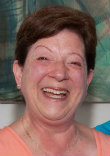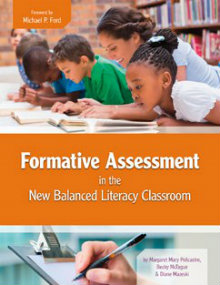Ongoing Assessment of New Balanced Literacy
Formative Assessment in the New Balanced Literacy Classroom
By Margaret Mary Policastro, Becky McTague, & Diane Mazeski
(Maupin House Publishing/Capstone, 2016 – Learn more)

Formative assessment…summative assessment…balanced literacy…NEW balanced literacy! These are terms which have consistently surfaced and resurfaced throughout my teaching career and which have at times given me pause, especially as I mentored pre- and in-service teachers. What do these terms look like in the classroom? What are best practices associated with them?

Their intention is clearly stated in Chapter 1: “The purpose of this book is to assist teachers and school leaders in the development of school-wide formative assessment practices. More specifically, we want to provide a step-by-step plan for classroom teachers to implement formative assessment.” And that is exactly what they do.
What you’ll find in the book
The book’s seven chapters are well organized. Chapter 1, “Introduction to Formative Assessment and Balanced Literacy,” defines the terms and clarifies what is meant by the “new” balanced literacy.
The authors identify the elements of traditional balanced literacy as read-aloud, guided reading groups, language and literacy centers, and independent reading and writing. They then go on to describe how implementation of the Common Core State Standards has necessitated shifts and changes in the balanced literacy approach and thus encouraged them to create the “New Balanced Literacy” elements:
► The New Read-Aloud (focusing on close reading and student discourse around texts from all content areas and poetry – 50% of texts should be informational in K-5 and 70% informational 6-12),
► The New Guiding Language into Reading (literacy instruction in all areas with 50% of texts being complex and informational, social discourse, academic vocabulary, 21st century research and communication tools, finding evidence in the text to support responses),
► Language and Literacy Centers (project based using 21st century research and communications tools, problem-solving, building arguments), and
► Independent Reading and Writing (balance of informational and disciplinary literacy texts, knowledge of language and language conventions, writing for various purposes).
Each of these new elements appears in an easily understandable chart that also includes formative assessments to go along with each element.
Chapters 2-5 take each element of the New Balanced Literacy described above and go into detail. Each of these chapters follows a consistent pattern of organization which makes it easy to follow:
- Snapshot of each element
- Classroom routine to establish for each element
- Formative assessment in action
- Formative collection
- Formative feedback
- Formative self-monitoring
- Formative assessment tools for each element
Suggestions for teacher talk/teacher writing also appear in each of these chapters. The formative assessment tools at the end of each chapter have permission to copy for classroom use and may be used as is or as a springboard for creation of tools specific to a teacher’s classroom.
Chapter 6: “A Guide for School Leaders on Implementing Formative Assessment School-wide” discusses the importance of administrative leadership in bringing about a school-wide shift to formative assessment and even includes a timeline for implementation.
Chapter 7: “Parents and Formative Assessment: Sending Feedback Home” brings the discussion to an effective close and gives many examples of possible communication tools to develop for parent/teacher/student formative assessment feedback.
The book ends with two lists: the first is 26 formative assessment strategies and the second, entitled “110 minutes of Formative Assessment Strategies,” puts the 26 strategies into the first column of a chart that has each new balanced literacy element as a column heading “so that you can get a sense of where they might fit into your balanced literacy instruction.”
Many of the strategies are old friends, tried and true but highly effective in gleaning student data. It actually made me feel very good to see so many of the strategies that I have used in the past – and probably didn’t realize that I was using a formative assessment tool to better meet the needs of my students!
An easy-to-use guide to formative assessment
The authors have written a very understandable, manageable book that is predictable in its organization and specific in its message. It is a text that I would’ve liked to have when I was first starting to implement a balanced literacy classroom, as it truly does give step-by-step guidance to using formative assessment to inform instruction.
This book would be an effective tool for elementary teachers since it has been my experience that middle school teachers do not usually include all balanced literacy classroom elements discussed in the book. However, I feel it would also be a worthwhile read for middle school teachers who want to learn more about formative assessment and how they would be able to implement it in what they do to guide their instruction.
Nancy Chodoroff is a retired educator who has enjoyed a varied teaching career. Starting as an elementary teacher, Nancy “graduated” to middle school where she taught reading and American history and served as a master teacher. She also had the privilege of serving on a national Middle Level Task Force in Washington, DC, and as an adjunct professor in Rider University’s College of Education (Lawrenceville, NJ). Nancy continues to share her love of teaching through her current work with the National Writing Project chapter at Rider University.




































